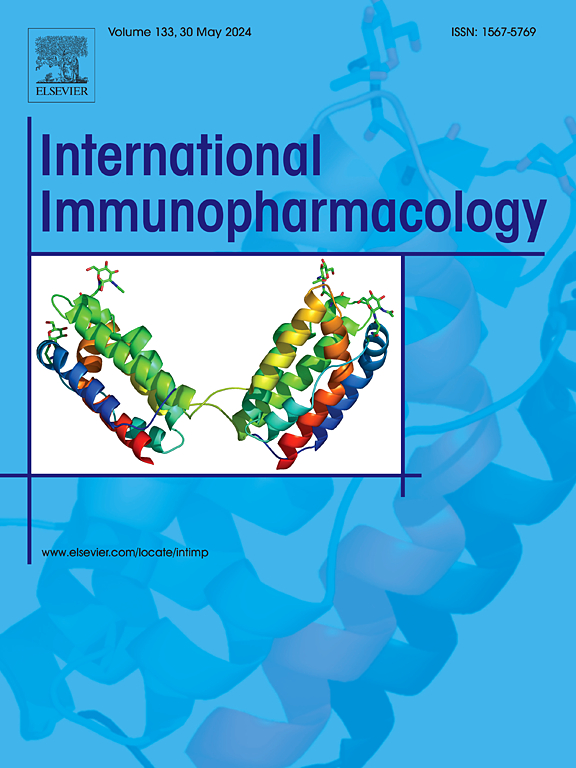Bafilomycin A1 mitigates subchondral bone degeneration and pain in TMJOA rats
IF 4.8
2区 医学
Q2 IMMUNOLOGY
引用次数: 0
Abstract
Background
Pain and disability are primary concerns for temporomandibular joint osteoarthritis (TMJOA) patients, and the efficacy of current treatments remains controversial. Overactive osteoclasts are associated with subchondral bone degeneration and pain in OA. The vacuolar H+-ATPase (V-ATPase) is crucial for differentiation and function in osteoclasts, but its role in TMJOA is not well defined. This study aims to evaluate the effects of the V-ATPase inhibitor, bafilomycin A1 (Baf A1) on the progression and pain of TMJOA.
Materials and methods
Pain behavior tests, histological staining, tartrate-resistant acid phosphatase (TRAP) staining, immunofluorescence staining, and micro-CT analysis were conducted to evaluate the therapeutic efficacy of Baf A1 in monosodium iodoacetate-induced TMJOA in rats. Additionally, TRAP staining, enzyme-linked immunosorbent assay and immunofluorescence staining were used to assess the inhibitory effects of Baf a1 on the osteoclastogenesis, secretion of netrin-1 and neurite growth of trigeminal ganglion (TG) neurons.
Results
Baf A1 significantly mitigated subchondral bone degeneration by suppressing osteoclastogenesis and subsequently inhibited cartilage degradation in TMJOA rats. Baf A1 also effectively alleviated pain behavior by inhibiting expression of netrin-1 and innervation of sensory nerve in TMJOA rats. In vitro assays of osteoclast and TG further demonstrated the inhibitory effects of Baf A1 on osteoclastogenesis, secretion of netrin-1 and neurite outgrowth of TG.
Conclusions
This study demonstrates that Baf A1 inhibits V-ATPase to mitigate TMJOA degeneration and pain by suppressing osteoclastogenesis and secretion of netrin-1, thereby suggesting it as a potential clinical treatment option for degeneration and pain of TMJOA.
巴菲霉素A1减轻TMJOA大鼠软骨下骨变性和疼痛。
背景:疼痛和残疾是颞下颌关节骨关节炎(TMJOA)患者最关心的问题,目前的治疗效果仍存在争议。破骨细胞过度活跃与骨性关节炎的软骨下骨变性和疼痛有关。空泡H+- atp酶(v - atp酶)对破骨细胞的分化和功能至关重要,但其在TMJOA中的作用尚未明确。本研究旨在评价v - atp酶抑制剂巴菲霉素A1 (Baf A1)对TMJOA进展和疼痛的影响。材料与方法:采用疼痛行为实验、组织学染色、抗酒石酸酸性磷酸酶(TRAP)染色、免疫荧光染色、显微ct分析等方法评价Baf A1对碘乙酸钠诱导大鼠TMJOA的治疗效果。此外,采用TRAP染色、酶联免疫吸附法和免疫荧光染色评估Baf a1对三叉神经节(TG)神经元破骨细胞生成、netrin-1分泌和神经突生长的抑制作用。结果:Baf A1通过抑制破骨细胞生成,从而显著减轻TMJOA大鼠软骨退化。Baf A1还通过抑制netrin-1的表达和感觉神经的支配,有效缓解TMJOA大鼠的疼痛行为。体外破骨细胞和TG实验进一步证实了Baf A1对破骨细胞生成、netrin-1分泌和TG神经突生长的抑制作用。结论:本研究表明,Baf A1通过抑制破骨细胞的生成和netrin-1的分泌,抑制v - atp酶减轻TMJOA变性和疼痛,提示其可能是TMJOA变性和疼痛的临床治疗选择。
本文章由计算机程序翻译,如有差异,请以英文原文为准。
求助全文
约1分钟内获得全文
求助全文
来源期刊
CiteScore
8.40
自引率
3.60%
发文量
935
审稿时长
53 days
期刊介绍:
International Immunopharmacology is the primary vehicle for the publication of original research papers pertinent to the overlapping areas of immunology, pharmacology, cytokine biology, immunotherapy, immunopathology and immunotoxicology. Review articles that encompass these subjects are also welcome.
The subject material appropriate for submission includes:
• Clinical studies employing immunotherapy of any type including the use of: bacterial and chemical agents; thymic hormones, interferon, lymphokines, etc., in transplantation and diseases such as cancer, immunodeficiency, chronic infection and allergic, inflammatory or autoimmune disorders.
• Studies on the mechanisms of action of these agents for specific parameters of immune competence as well as the overall clinical state.
• Pre-clinical animal studies and in vitro studies on mechanisms of action with immunopotentiators, immunomodulators, immunoadjuvants and other pharmacological agents active on cells participating in immune or allergic responses.
• Pharmacological compounds, microbial products and toxicological agents that affect the lymphoid system, and their mechanisms of action.
• Agents that activate genes or modify transcription and translation within the immune response.
• Substances activated, generated, or released through immunologic or related pathways that are pharmacologically active.
• Production, function and regulation of cytokines and their receptors.
• Classical pharmacological studies on the effects of chemokines and bioactive factors released during immunological reactions.

 求助内容:
求助内容: 应助结果提醒方式:
应助结果提醒方式:


